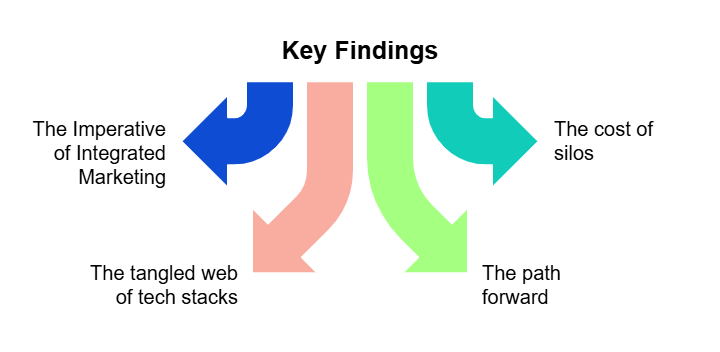Marketers are facing a tidal wave of complexity. From navigating the intricacies of AI-driven search to understanding the increasingly non-linear customer journey, the challenges are multifaceted and demanding.
“The Costs of Complexity,” a new 2025 commissioned study conducted by Forrester Consulting, plunges headlong into this turbulence to help show marketers a practical way forward: one where unified technology delivers both better CX and improved ROI.
The marketing minefield
Broadly speaking, marketers across industries are in a state of constantly juggling priorities like improving performance, investing in new technology and experiences, and increasing customer loyalty, all while navigating in a landscape where customers’ attention is increasingly fragmented.
If anything, it only gets more complicated — not less — as time goes on.
For content and SEO teams, there’s yet another layer of complexity: figuring out how to measure content ROI when there’s an overload of AI-generated content, volatile algorithms, and ever-changing search results pages.
That’s a lot to wrangle, but the Forrester study includes findings that are validating (so many of us wrestle with the same issues) and practical in terms of next steps.

Key finding #1: The imperative of integrated marketing
The Forrester study highlights just how badly marketers want and need a holistic understanding of the customer journey. Indeed, 70 percent of surveyed marketers believe that the ability to integrate paid and earned media is crucial for their marketing efforts.
To pull that off, however, silos need to be dismantled and data from different parts of the marketing engine need to be harmonized.
Key finding #2: The tangled web of tech stacks
Another finding of the Forrester survey: Sixty-two percent of marketers struggle with overly complex tech stacks, often accumulated over years of adopting point solutions. Furthermore, 59 percent lack critical marketing performance technologies that can unify their efforts.
What we all need is a streamlined solution that’s sophisticated enough (which means powered by AI) to connect the dots among very different digital disciplines, including content strategy, brand, analytics, and search, and then power holistic strategy.
That can only come in the form of martech that links seemingly disparate marketing activities to tangible business outcomes.
Key finding #3: The cost of silos
The Forrester study also points to silos, both between teams and data, as a significant hindrance to customer experience and business growth. Until these silos are dismantled, the inevitable result is wasted resources, missed opportunities, and lack of unified brand presence.
It boils down to this: A company’s marketing efforts need to function as more than a sum of parts, especially during times of economic downturn. It’s not hard to draw a direct line from inefficiencies to lost share of voice.
Key finding #4: The path forward
The good news, the Forrester study found, is that marketers recognize the need for change. Their study found that two out of three marketers plan to implement or expand their marketing performance solutions in the next year. This includes increasing investment in SEO and combining tasks through automation to achieve higher quality data and greater customer lifetime value.
Actionable insights and recommendations
Also good news? There are multiple (and very clear) ways forward. Based on the study and our recent webinar featuring Forrester, we arrived at these insights and recommendations:
Prioritize time to value:
Focus on people, processes, and technologies that minimize the time it takes to achieve marketing results. Be mindful of short-term gains versus long-term tech debt.
Focus on customer understanding:
Deeply analyze buyer journeys using both quantitative and qualitative data, as well as social listening, search listening, and creative testing.
Integrate paid and earned media with accessibility:
Make sure these core pillars work synergistically to create a cohesive and inclusive customer experience. After all, accessibility is not just a "nice-to-have" but a fundamental aspect of customer experience and brand trust; it’s the foundation of the exchange of goodwill you’re cultivating with your customers.
Embrace quality over quantity:
In an era of AI-generated content, focus on creating high-quality, authoritative, differentiated, clear, and editorially sound content that resonates with your target audience. Define your brand's unique point of view to stand out and recognize that just one sub-par piece of content that’s been generated by AI will degrade your brand.
Establish a clear framework with defined responsibilities and policies:
When each team member understands their role, communication and decision-making processes are clarified. That clarity helps reduce redundancies among your martech tools.
Foster a data-driven culture across teams:
Data is the lynchpin of informed decision making. When you embrace the “everything is connected” approach to your data, you need to prime your team to look at their work through that lens.
Prioritize data security and privacy:
When your data is generated by one consolidated martech solution, you’re in a far better position to implement robust, streamlined security measures and comply with privacy regulations like GDPR and, if you work in healthcare, HIPAA.
Leverage technology to automate data governance processes:
The more you rely on automation, the less risk there is of human error. AI-powered tools can monitor data usage and enforce compliance, not to mention generate real-time reports.
Start small:
Focus on a few key metrics that matter most to your brand. A simplified martech stack will consolidate your data sources and analytics and more easily surface key actionable insights.
Aim for “good enough,” unified data:
Fractured martech data prompts marketers to focus on reconciling discrepancies. When you’ve got a single, cohesive system generating your data, you can get right to executing on insights.
Again, consolidation leads to simplicity, simplicity leads to focus, and focus leads to better outcomes.
The future of websites
There’s one, “big-picture” reason to consolidate and simplify now: The very purpose of websites is likely to transform in the next five years. Upper- and mid-level funnel activities will increasingly happen directly on SERPS (courtesy of AI-driven search), and websites will be even more crucial for harvesting demand and providing in-depth research for qualified leads. A simplified martech stack — one that’s distinguished by efficient data management and analytics — will prime you to stay ahead of that transformation.
Ready to cut through the complexity and unify your marketing performance? Download the complete Forrester study, “The Costs of Complexity,” to gain deeper insights into how simplifying your martech can enhance your CX and ROI and prepare you for the future.


